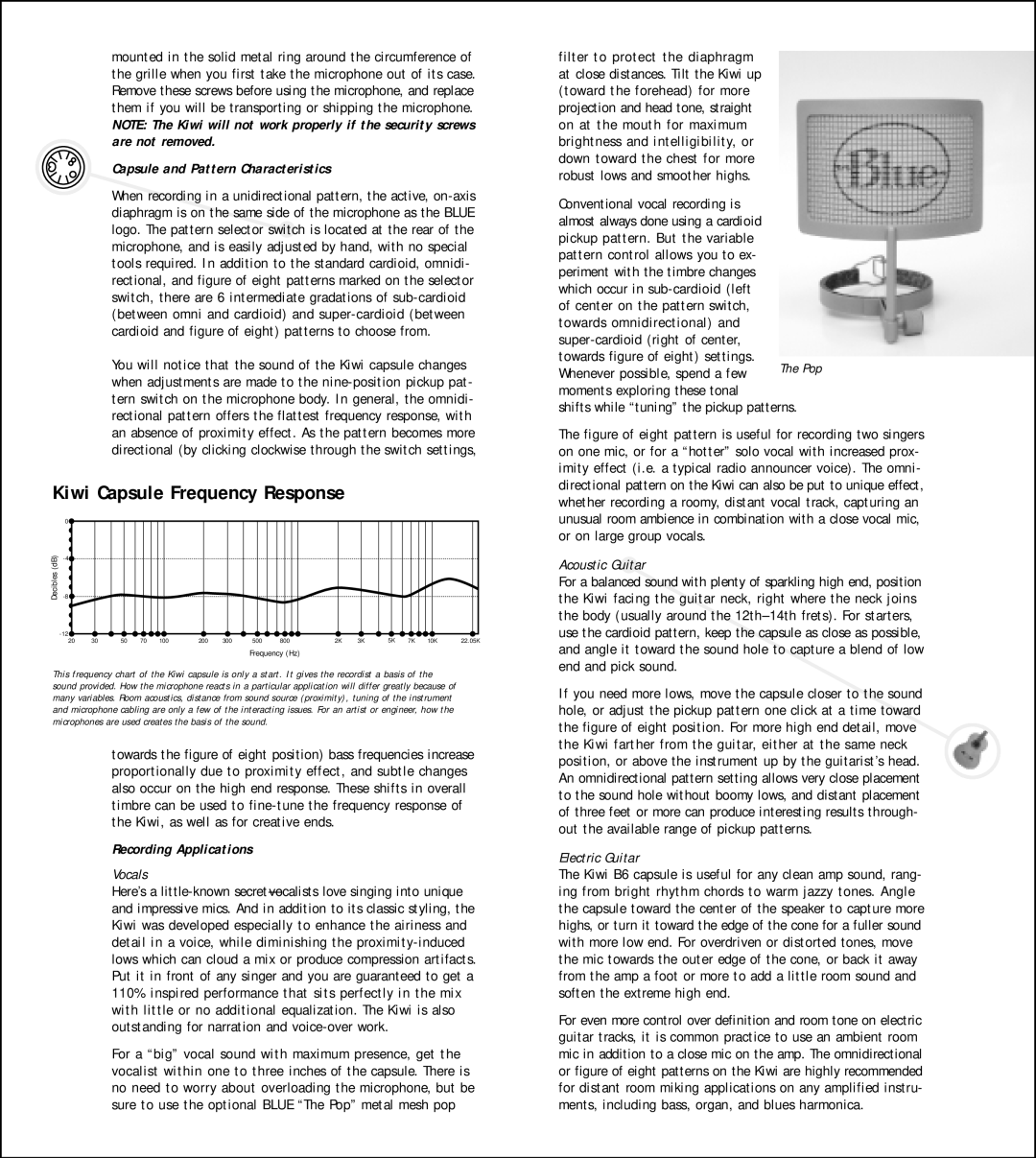
mounted in the solid metal ring around the circumference of the grille when you first take the microphone out of its case. Remove these screws before using the microphone, and replace them if you will be transporting or shipping the microphone.
NOTE: The Kiwi will not work properly if the security screws are not removed.
Capsule and Pattern Characteristics
When recording in a unidirectional pattern, the active,
You will notice that the sound of the Kiwi capsule changes when adjustments are made to the
Kiwi Capsule Frequency Response
0 |
Decibles(dB) |
|
|
|
|
|
|
|
|
|
|
|
|
|
|
| |
|
|
|
|
|
|
|
|
|
|
|
|
|
|
|
| |
|
|
|
|
|
|
|
|
|
|
|
|
|
|
|
| |
|
|
|
|
|
|
|
|
|
|
|
| 5K |
|
|
| |
| 20 | 30 | 50 | 70 | 100 | 200 | 300 | 500 | 800 | 2K | 3K | 7K | 10K | 22.05K | ||
Frequency (Hz)
This frequency chart of the Kiwi capsule is only a start. It gives the recordist a basis of the sound provided. How the microphone reacts in a particular application will differ greatly because of many variables. Room acoustics, distance from sound source (proximity), tuning of the instrument and microphone cabling are only a few of the interacting issues. For an artist or engineer, how the microphones are used creates the basis of the sound.
towards the figure of eight position) bass frequencies increase proportionally due to proximity effect, and subtle changes also occur on the high end response. These shifts in overall timbre can be used to
Recording Applications
Vocals
Here’s a
For a “big” vocal sound with maximum presence, get the vocalist within one to three inches of the capsule. There is no need to worry about overloading the microphone, but be sure to use the optional BLUE “The Pop” metal mesh pop
filter to protect the diaphragm at close distances. Tilt the Kiwi up (toward the forehead) for more projection and head tone, straight on at the mouth for maximum brightness and intelligibility, or down toward the chest for more robust lows and smoother highs.
Conventional vocal recording is almost always done using a cardioid pickup pattern. But the variable pattern control allows you to ex- periment with the timbre changes which occur in
shifts while “tuning” the pickup patterns.
The figure of eight pattern is useful for recording two singers on one mic, or for a “hotter” solo vocal with increased prox- imity effect (i.e. a typical radio announcer voice). The omni- directional pattern on the Kiwi can also be put to unique effect, whether recording a roomy, distant vocal track, capturing an unusual room ambience in combination with a close vocal mic, or on large group vocals.
Acoustic Guitar
For a balanced sound with plenty of sparkling high end, position the Kiwi facing the guitar neck, right where the neck joins the body (usually around the
If you need more lows, move the capsule closer to the sound hole, or adjust the pickup pattern one click at a time toward the figure of eight position. For more high end detail, move the Kiwi farther from the guitar, either at the same neck position, or above the instrument up by the guitarist’s head. An omnidirectional pattern setting allows very close placement to the sound hole without boomy lows, and distant placement of three feet or more can produce interesting results through- out the available range of pickup patterns.
Electric Guitar
The Kiwi B6 capsule is useful for any clean amp sound, rang- ing from bright rhythm chords to warm jazzy tones. Angle the capsule toward the center of the speaker to capture more highs, or turn it toward the edge of the cone for a fuller sound with more low end. For overdriven or distorted tones, move the mic towards the outer edge of the cone, or back it away from the amp a foot or more to add a little room sound and soften the extreme high end.
For even more control over definition and room tone on electric guitar tracks, it is common practice to use an ambient room mic in addition to a close mic on the amp. The omnidirectional or figure of eight patterns on the Kiwi are highly recommended for distant room miking applications on any amplified instru- ments, including bass, organ, and blues harmonica.
